Business Finance Report: Financial Analysis of UberTools & Madagascar
VerifiedAdded on 2020/10/22
|10
|3370
|379
Report
AI Summary
This report delves into the core concepts of business finance, focusing on profit, cash flow, working capital, inventory, receivables, and payables. It examines how changes in working capital affect cash flow and applies these concepts to manage financial results. The report analyzes the financial performance of Madagascar Industries Ltd through ratio calculations and offers recommendations to improve cash flow through better working capital management, including leasing, inventory management, credit checks, using up-to-date financial information, and electronic payments. The report also discusses elements of financial performance, calculates key financial ratios for the company, and analyzes their implications for the business's financial health and future success. The report provides a detailed analysis of financial results and offers recommendations to improve cash flow through better working capital management.
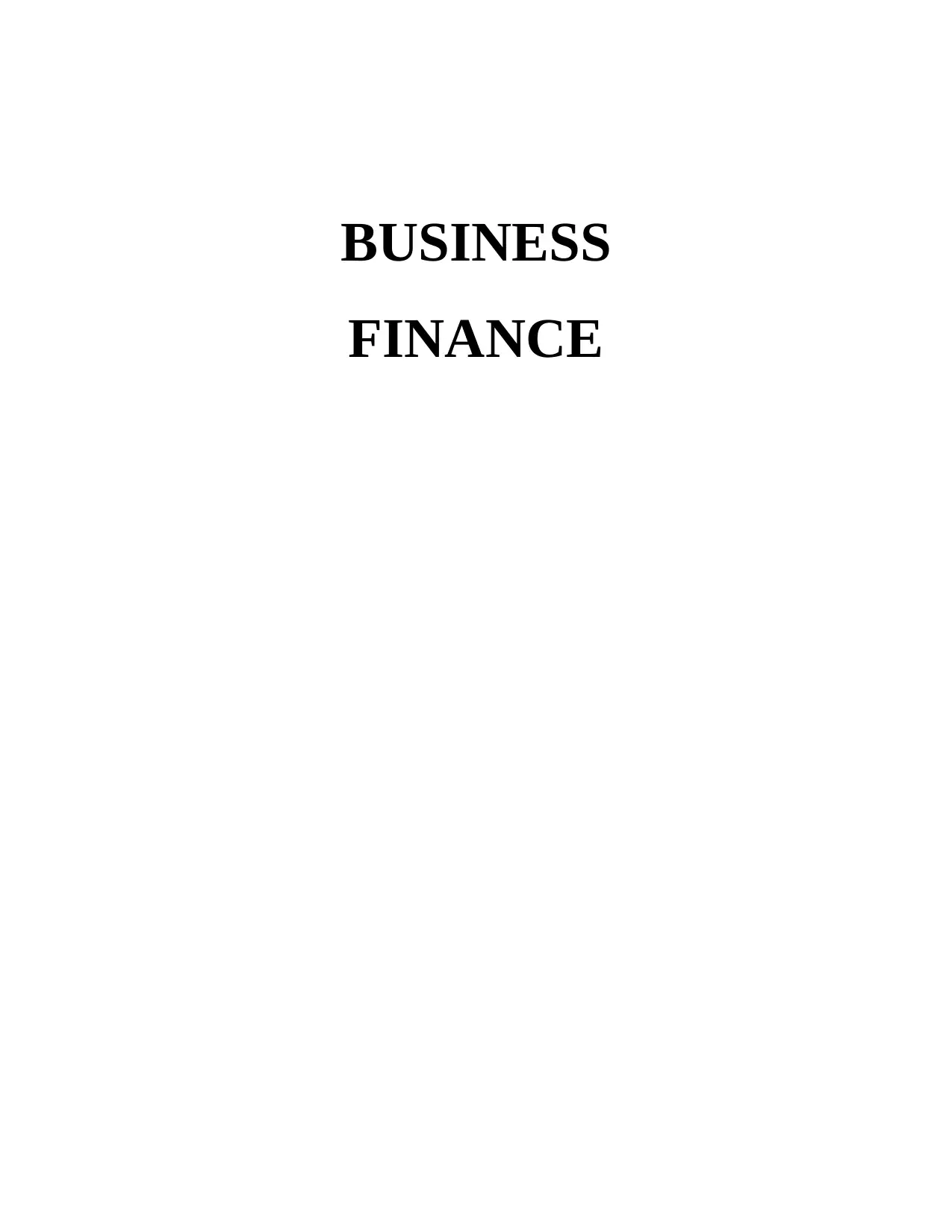
BUSINESS
FINANCE
FINANCE
Paraphrase This Document
Need a fresh take? Get an instant paraphrase of this document with our AI Paraphraser
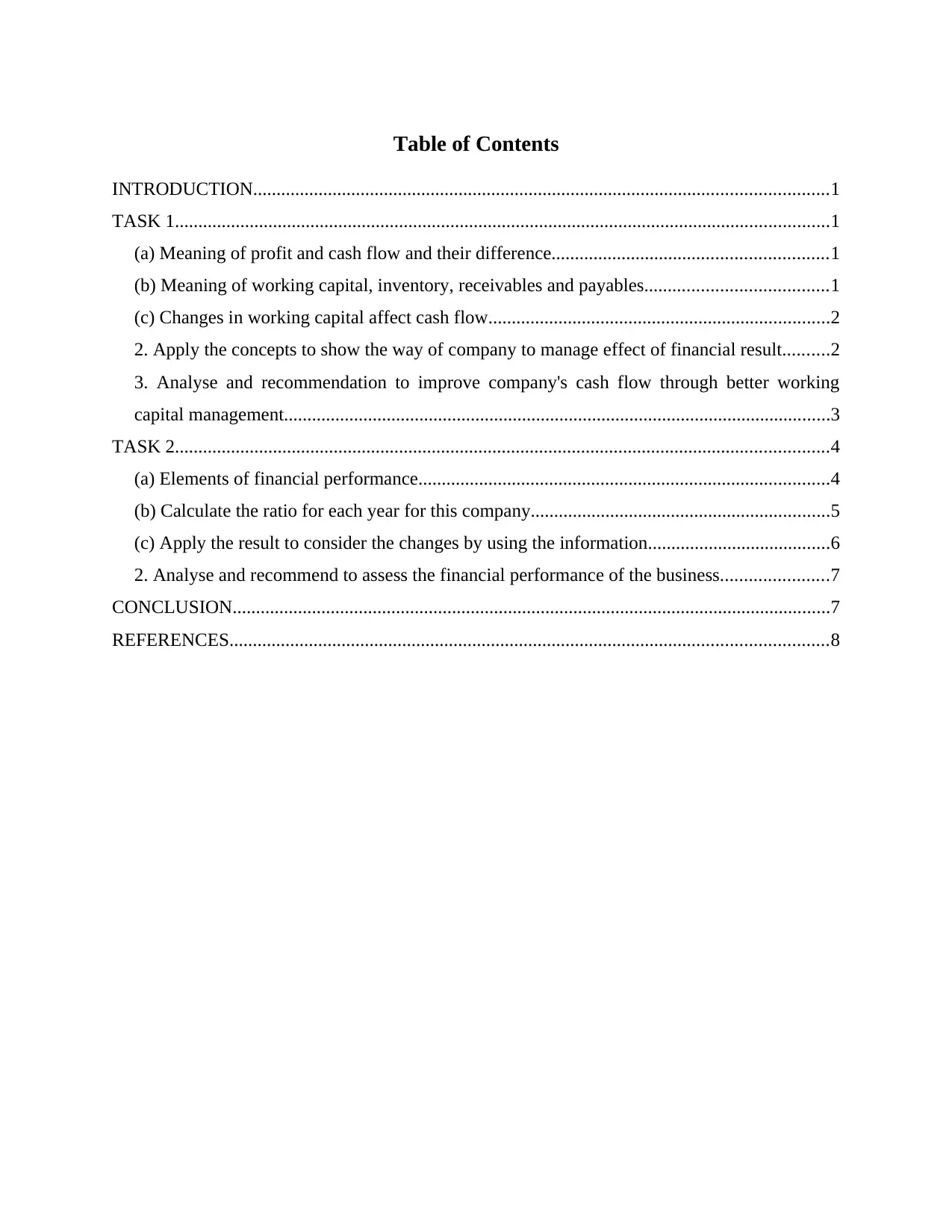
Table of Contents
INTRODUCTION...........................................................................................................................1
TASK 1............................................................................................................................................1
(a) Meaning of profit and cash flow and their difference...........................................................1
(b) Meaning of working capital, inventory, receivables and payables.......................................1
(c) Changes in working capital affect cash flow.........................................................................2
2. Apply the concepts to show the way of company to manage effect of financial result..........2
3. Analyse and recommendation to improve company's cash flow through better working
capital management.....................................................................................................................3
TASK 2............................................................................................................................................4
(a) Elements of financial performance........................................................................................4
(b) Calculate the ratio for each year for this company................................................................5
(c) Apply the result to consider the changes by using the information.......................................6
2. Analyse and recommend to assess the financial performance of the business.......................7
CONCLUSION................................................................................................................................7
REFERENCES................................................................................................................................8
INTRODUCTION...........................................................................................................................1
TASK 1............................................................................................................................................1
(a) Meaning of profit and cash flow and their difference...........................................................1
(b) Meaning of working capital, inventory, receivables and payables.......................................1
(c) Changes in working capital affect cash flow.........................................................................2
2. Apply the concepts to show the way of company to manage effect of financial result..........2
3. Analyse and recommendation to improve company's cash flow through better working
capital management.....................................................................................................................3
TASK 2............................................................................................................................................4
(a) Elements of financial performance........................................................................................4
(b) Calculate the ratio for each year for this company................................................................5
(c) Apply the result to consider the changes by using the information.......................................6
2. Analyse and recommend to assess the financial performance of the business.......................7
CONCLUSION................................................................................................................................7
REFERENCES................................................................................................................................8
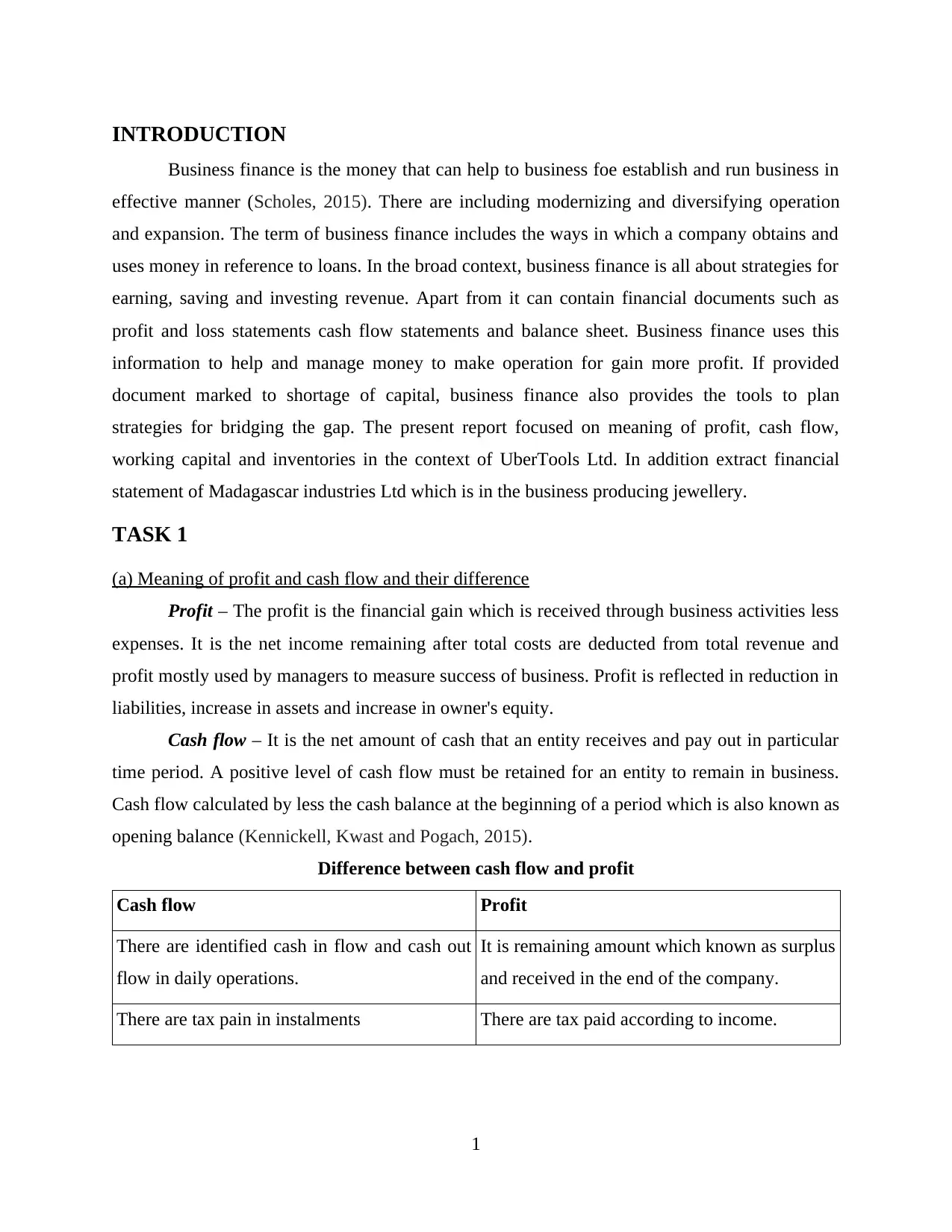
INTRODUCTION
Business finance is the money that can help to business foe establish and run business in
effective manner (Scholes, 2015). There are including modernizing and diversifying operation
and expansion. The term of business finance includes the ways in which a company obtains and
uses money in reference to loans. In the broad context, business finance is all about strategies for
earning, saving and investing revenue. Apart from it can contain financial documents such as
profit and loss statements cash flow statements and balance sheet. Business finance uses this
information to help and manage money to make operation for gain more profit. If provided
document marked to shortage of capital, business finance also provides the tools to plan
strategies for bridging the gap. The present report focused on meaning of profit, cash flow,
working capital and inventories in the context of UberTools Ltd. In addition extract financial
statement of Madagascar industries Ltd which is in the business producing jewellery.
TASK 1
(a) Meaning of profit and cash flow and their difference
Profit – The profit is the financial gain which is received through business activities less
expenses. It is the net income remaining after total costs are deducted from total revenue and
profit mostly used by managers to measure success of business. Profit is reflected in reduction in
liabilities, increase in assets and increase in owner's equity.
Cash flow – It is the net amount of cash that an entity receives and pay out in particular
time period. A positive level of cash flow must be retained for an entity to remain in business.
Cash flow calculated by less the cash balance at the beginning of a period which is also known as
opening balance (Kennickell, Kwast and Pogach, 2015).
Difference between cash flow and profit
Cash flow Profit
There are identified cash in flow and cash out
flow in daily operations.
It is remaining amount which known as surplus
and received in the end of the company.
There are tax pain in instalments There are tax paid according to income.
1
Business finance is the money that can help to business foe establish and run business in
effective manner (Scholes, 2015). There are including modernizing and diversifying operation
and expansion. The term of business finance includes the ways in which a company obtains and
uses money in reference to loans. In the broad context, business finance is all about strategies for
earning, saving and investing revenue. Apart from it can contain financial documents such as
profit and loss statements cash flow statements and balance sheet. Business finance uses this
information to help and manage money to make operation for gain more profit. If provided
document marked to shortage of capital, business finance also provides the tools to plan
strategies for bridging the gap. The present report focused on meaning of profit, cash flow,
working capital and inventories in the context of UberTools Ltd. In addition extract financial
statement of Madagascar industries Ltd which is in the business producing jewellery.
TASK 1
(a) Meaning of profit and cash flow and their difference
Profit – The profit is the financial gain which is received through business activities less
expenses. It is the net income remaining after total costs are deducted from total revenue and
profit mostly used by managers to measure success of business. Profit is reflected in reduction in
liabilities, increase in assets and increase in owner's equity.
Cash flow – It is the net amount of cash that an entity receives and pay out in particular
time period. A positive level of cash flow must be retained for an entity to remain in business.
Cash flow calculated by less the cash balance at the beginning of a period which is also known as
opening balance (Kennickell, Kwast and Pogach, 2015).
Difference between cash flow and profit
Cash flow Profit
There are identified cash in flow and cash out
flow in daily operations.
It is remaining amount which known as surplus
and received in the end of the company.
There are tax pain in instalments There are tax paid according to income.
1
⊘ This is a preview!⊘
Do you want full access?
Subscribe today to unlock all pages.

Trusted by 1+ million students worldwide
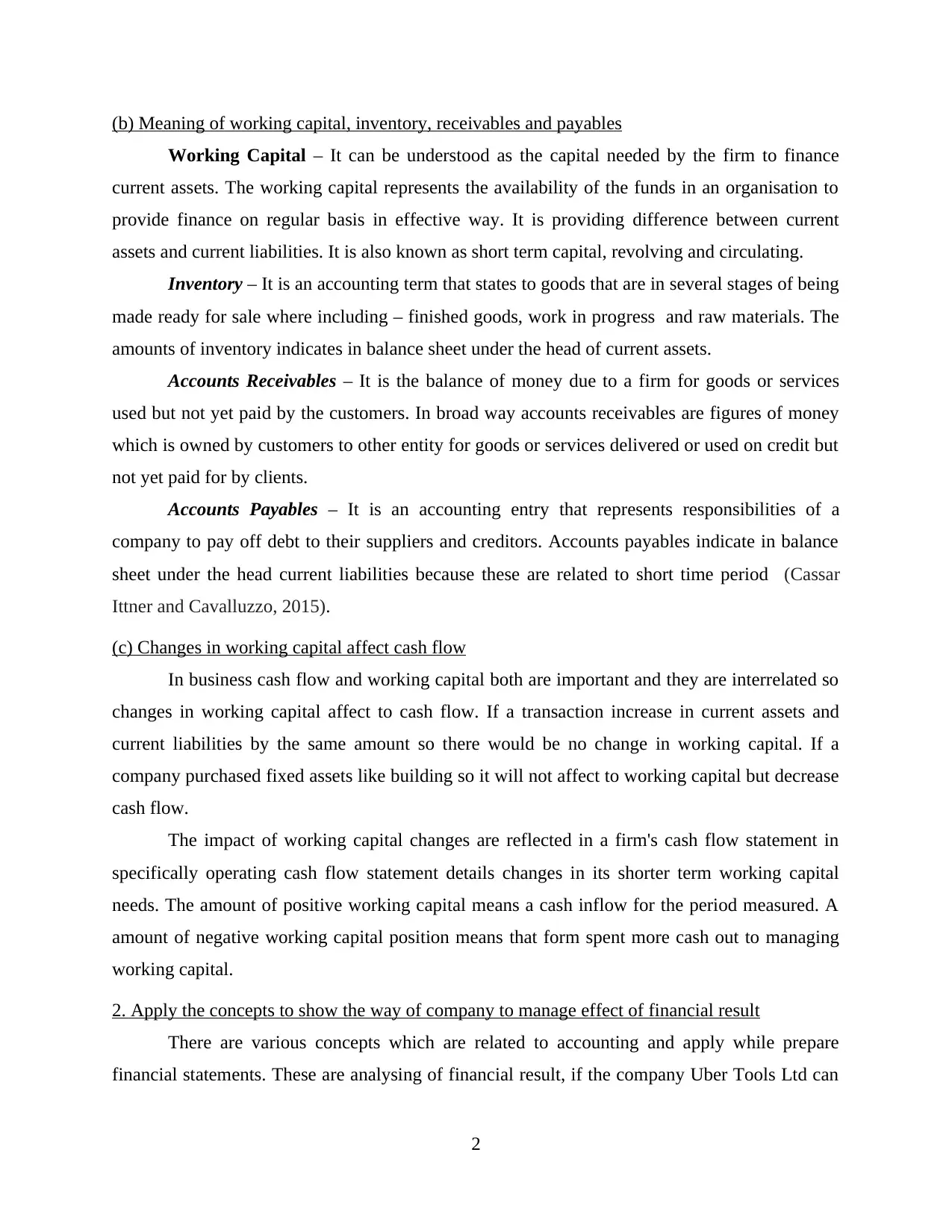
(b) Meaning of working capital, inventory, receivables and payables
Working Capital – It can be understood as the capital needed by the firm to finance
current assets. The working capital represents the availability of the funds in an organisation to
provide finance on regular basis in effective way. It is providing difference between current
assets and current liabilities. It is also known as short term capital, revolving and circulating.
Inventory – It is an accounting term that states to goods that are in several stages of being
made ready for sale where including – finished goods, work in progress and raw materials. The
amounts of inventory indicates in balance sheet under the head of current assets.
Accounts Receivables – It is the balance of money due to a firm for goods or services
used but not yet paid by the customers. In broad way accounts receivables are figures of money
which is owned by customers to other entity for goods or services delivered or used on credit but
not yet paid for by clients.
Accounts Payables – It is an accounting entry that represents responsibilities of a
company to pay off debt to their suppliers and creditors. Accounts payables indicate in balance
sheet under the head current liabilities because these are related to short time period (Cassar
Ittner and Cavalluzzo, 2015).
(c) Changes in working capital affect cash flow
In business cash flow and working capital both are important and they are interrelated so
changes in working capital affect to cash flow. If a transaction increase in current assets and
current liabilities by the same amount so there would be no change in working capital. If a
company purchased fixed assets like building so it will not affect to working capital but decrease
cash flow.
The impact of working capital changes are reflected in a firm's cash flow statement in
specifically operating cash flow statement details changes in its shorter term working capital
needs. The amount of positive working capital means a cash inflow for the period measured. A
amount of negative working capital position means that form spent more cash out to managing
working capital.
2. Apply the concepts to show the way of company to manage effect of financial result
There are various concepts which are related to accounting and apply while prepare
financial statements. These are analysing of financial result, if the company Uber Tools Ltd can
2
Working Capital – It can be understood as the capital needed by the firm to finance
current assets. The working capital represents the availability of the funds in an organisation to
provide finance on regular basis in effective way. It is providing difference between current
assets and current liabilities. It is also known as short term capital, revolving and circulating.
Inventory – It is an accounting term that states to goods that are in several stages of being
made ready for sale where including – finished goods, work in progress and raw materials. The
amounts of inventory indicates in balance sheet under the head of current assets.
Accounts Receivables – It is the balance of money due to a firm for goods or services
used but not yet paid by the customers. In broad way accounts receivables are figures of money
which is owned by customers to other entity for goods or services delivered or used on credit but
not yet paid for by clients.
Accounts Payables – It is an accounting entry that represents responsibilities of a
company to pay off debt to their suppliers and creditors. Accounts payables indicate in balance
sheet under the head current liabilities because these are related to short time period (Cassar
Ittner and Cavalluzzo, 2015).
(c) Changes in working capital affect cash flow
In business cash flow and working capital both are important and they are interrelated so
changes in working capital affect to cash flow. If a transaction increase in current assets and
current liabilities by the same amount so there would be no change in working capital. If a
company purchased fixed assets like building so it will not affect to working capital but decrease
cash flow.
The impact of working capital changes are reflected in a firm's cash flow statement in
specifically operating cash flow statement details changes in its shorter term working capital
needs. The amount of positive working capital means a cash inflow for the period measured. A
amount of negative working capital position means that form spent more cash out to managing
working capital.
2. Apply the concepts to show the way of company to manage effect of financial result
There are various concepts which are related to accounting and apply while prepare
financial statements. These are analysing of financial result, if the company Uber Tools Ltd can
2
Paraphrase This Document
Need a fresh take? Get an instant paraphrase of this document with our AI Paraphraser
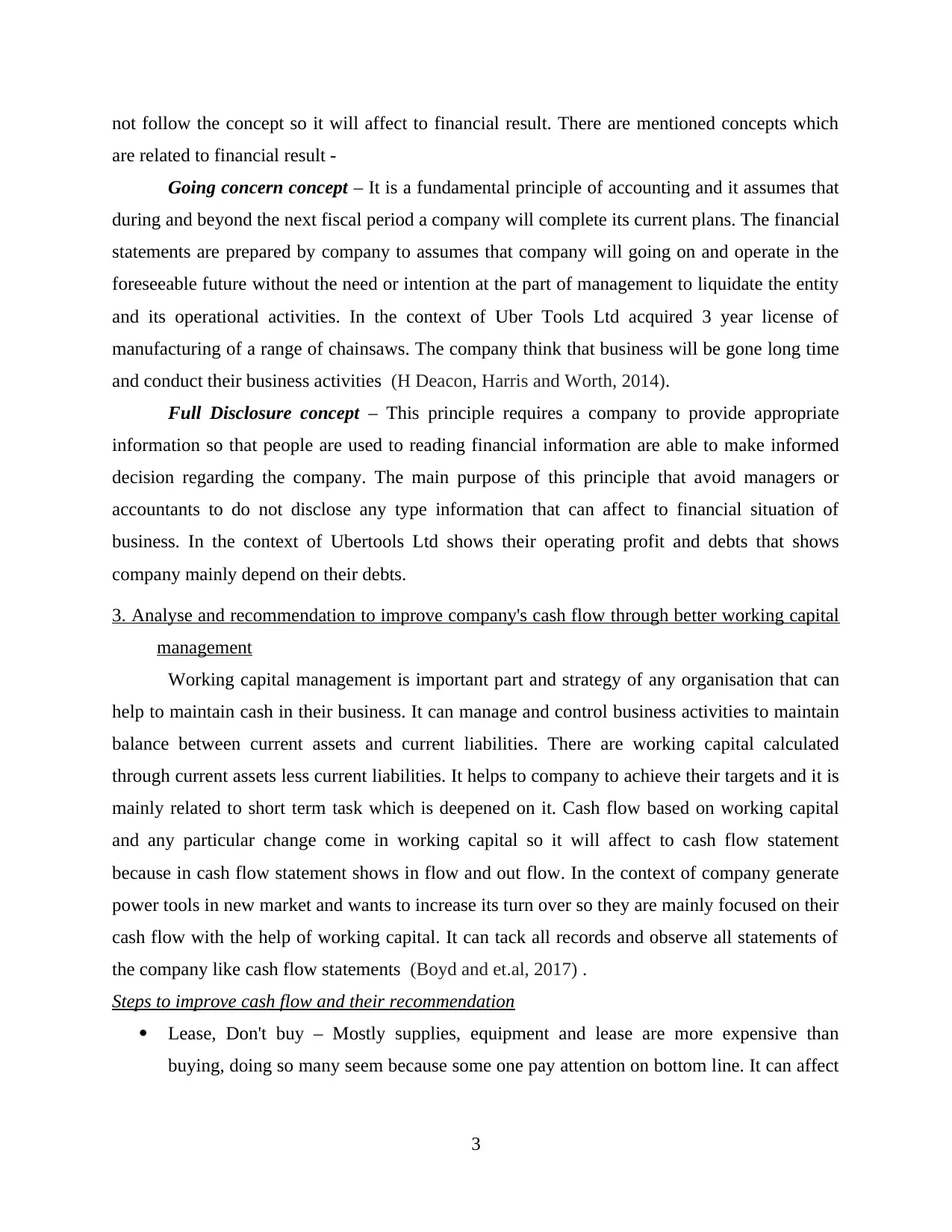
not follow the concept so it will affect to financial result. There are mentioned concepts which
are related to financial result -
Going concern concept – It is a fundamental principle of accounting and it assumes that
during and beyond the next fiscal period a company will complete its current plans. The financial
statements are prepared by company to assumes that company will going on and operate in the
foreseeable future without the need or intention at the part of management to liquidate the entity
and its operational activities. In the context of Uber Tools Ltd acquired 3 year license of
manufacturing of a range of chainsaws. The company think that business will be gone long time
and conduct their business activities (H Deacon, Harris and Worth, 2014).
Full Disclosure concept – This principle requires a company to provide appropriate
information so that people are used to reading financial information are able to make informed
decision regarding the company. The main purpose of this principle that avoid managers or
accountants to do not disclose any type information that can affect to financial situation of
business. In the context of Ubertools Ltd shows their operating profit and debts that shows
company mainly depend on their debts.
3. Analyse and recommendation to improve company's cash flow through better working capital
management
Working capital management is important part and strategy of any organisation that can
help to maintain cash in their business. It can manage and control business activities to maintain
balance between current assets and current liabilities. There are working capital calculated
through current assets less current liabilities. It helps to company to achieve their targets and it is
mainly related to short term task which is deepened on it. Cash flow based on working capital
and any particular change come in working capital so it will affect to cash flow statement
because in cash flow statement shows in flow and out flow. In the context of company generate
power tools in new market and wants to increase its turn over so they are mainly focused on their
cash flow with the help of working capital. It can tack all records and observe all statements of
the company like cash flow statements (Boyd and et.al, 2017) .
Steps to improve cash flow and their recommendation
Lease, Don't buy – Mostly supplies, equipment and lease are more expensive than
buying, doing so many seem because some one pay attention on bottom line. It can affect
3
are related to financial result -
Going concern concept – It is a fundamental principle of accounting and it assumes that
during and beyond the next fiscal period a company will complete its current plans. The financial
statements are prepared by company to assumes that company will going on and operate in the
foreseeable future without the need or intention at the part of management to liquidate the entity
and its operational activities. In the context of Uber Tools Ltd acquired 3 year license of
manufacturing of a range of chainsaws. The company think that business will be gone long time
and conduct their business activities (H Deacon, Harris and Worth, 2014).
Full Disclosure concept – This principle requires a company to provide appropriate
information so that people are used to reading financial information are able to make informed
decision regarding the company. The main purpose of this principle that avoid managers or
accountants to do not disclose any type information that can affect to financial situation of
business. In the context of Ubertools Ltd shows their operating profit and debts that shows
company mainly depend on their debts.
3. Analyse and recommendation to improve company's cash flow through better working capital
management
Working capital management is important part and strategy of any organisation that can
help to maintain cash in their business. It can manage and control business activities to maintain
balance between current assets and current liabilities. There are working capital calculated
through current assets less current liabilities. It helps to company to achieve their targets and it is
mainly related to short term task which is deepened on it. Cash flow based on working capital
and any particular change come in working capital so it will affect to cash flow statement
because in cash flow statement shows in flow and out flow. In the context of company generate
power tools in new market and wants to increase its turn over so they are mainly focused on their
cash flow with the help of working capital. It can tack all records and observe all statements of
the company like cash flow statements (Boyd and et.al, 2017) .
Steps to improve cash flow and their recommendation
Lease, Don't buy – Mostly supplies, equipment and lease are more expensive than
buying, doing so many seem because some one pay attention on bottom line. It can affect
3
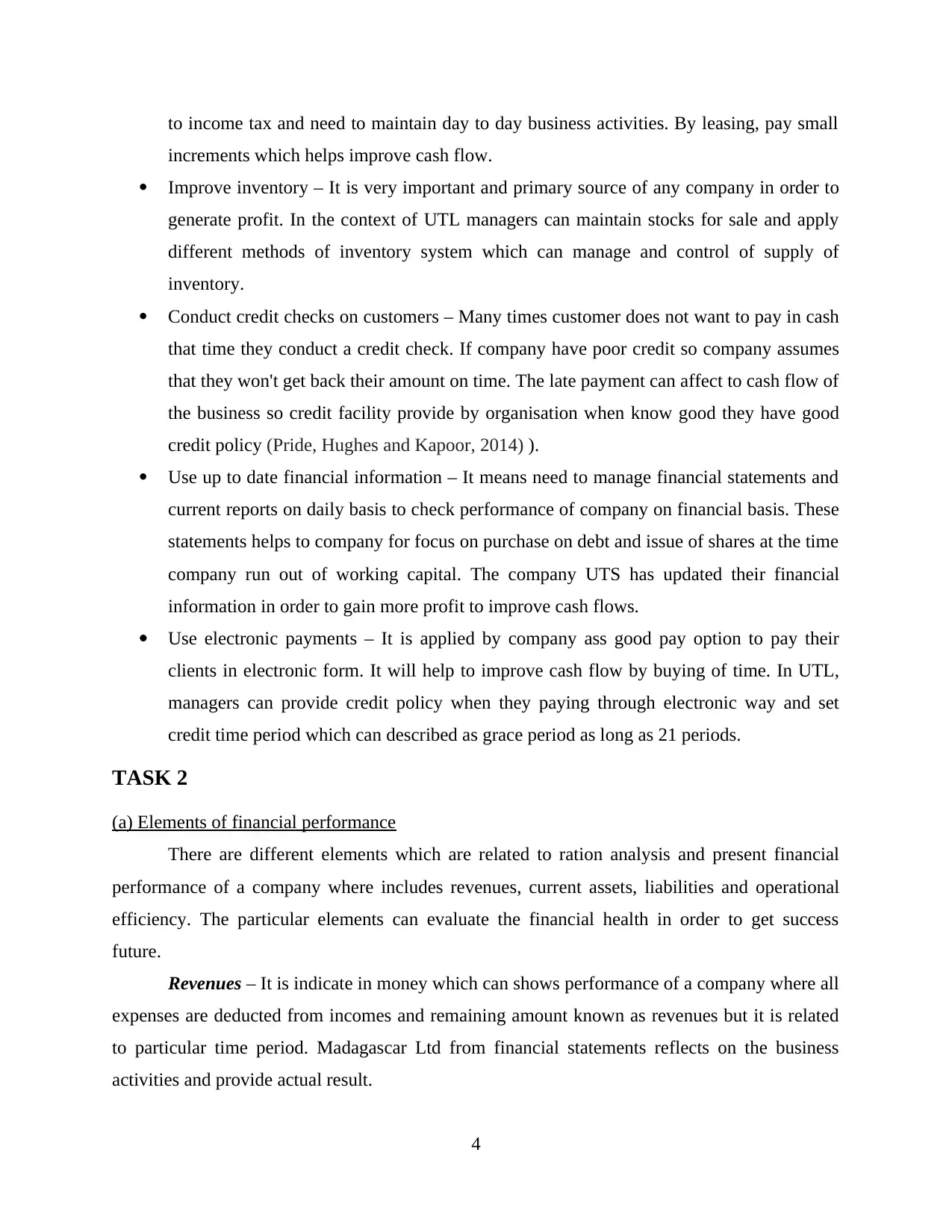
to income tax and need to maintain day to day business activities. By leasing, pay small
increments which helps improve cash flow.
Improve inventory – It is very important and primary source of any company in order to
generate profit. In the context of UTL managers can maintain stocks for sale and apply
different methods of inventory system which can manage and control of supply of
inventory.
Conduct credit checks on customers – Many times customer does not want to pay in cash
that time they conduct a credit check. If company have poor credit so company assumes
that they won't get back their amount on time. The late payment can affect to cash flow of
the business so credit facility provide by organisation when know good they have good
credit policy (Pride, Hughes and Kapoor, 2014) ).
Use up to date financial information – It means need to manage financial statements and
current reports on daily basis to check performance of company on financial basis. These
statements helps to company for focus on purchase on debt and issue of shares at the time
company run out of working capital. The company UTS has updated their financial
information in order to gain more profit to improve cash flows.
Use electronic payments – It is applied by company ass good pay option to pay their
clients in electronic form. It will help to improve cash flow by buying of time. In UTL,
managers can provide credit policy when they paying through electronic way and set
credit time period which can described as grace period as long as 21 periods.
TASK 2
(a) Elements of financial performance
There are different elements which are related to ration analysis and present financial
performance of a company where includes revenues, current assets, liabilities and operational
efficiency. The particular elements can evaluate the financial health in order to get success
future.
Revenues – It is indicate in money which can shows performance of a company where all
expenses are deducted from incomes and remaining amount known as revenues but it is related
to particular time period. Madagascar Ltd from financial statements reflects on the business
activities and provide actual result.
4
increments which helps improve cash flow.
Improve inventory – It is very important and primary source of any company in order to
generate profit. In the context of UTL managers can maintain stocks for sale and apply
different methods of inventory system which can manage and control of supply of
inventory.
Conduct credit checks on customers – Many times customer does not want to pay in cash
that time they conduct a credit check. If company have poor credit so company assumes
that they won't get back their amount on time. The late payment can affect to cash flow of
the business so credit facility provide by organisation when know good they have good
credit policy (Pride, Hughes and Kapoor, 2014) ).
Use up to date financial information – It means need to manage financial statements and
current reports on daily basis to check performance of company on financial basis. These
statements helps to company for focus on purchase on debt and issue of shares at the time
company run out of working capital. The company UTS has updated their financial
information in order to gain more profit to improve cash flows.
Use electronic payments – It is applied by company ass good pay option to pay their
clients in electronic form. It will help to improve cash flow by buying of time. In UTL,
managers can provide credit policy when they paying through electronic way and set
credit time period which can described as grace period as long as 21 periods.
TASK 2
(a) Elements of financial performance
There are different elements which are related to ration analysis and present financial
performance of a company where includes revenues, current assets, liabilities and operational
efficiency. The particular elements can evaluate the financial health in order to get success
future.
Revenues – It is indicate in money which can shows performance of a company where all
expenses are deducted from incomes and remaining amount known as revenues but it is related
to particular time period. Madagascar Ltd from financial statements reflects on the business
activities and provide actual result.
4
⊘ This is a preview!⊘
Do you want full access?
Subscribe today to unlock all pages.

Trusted by 1+ million students worldwide
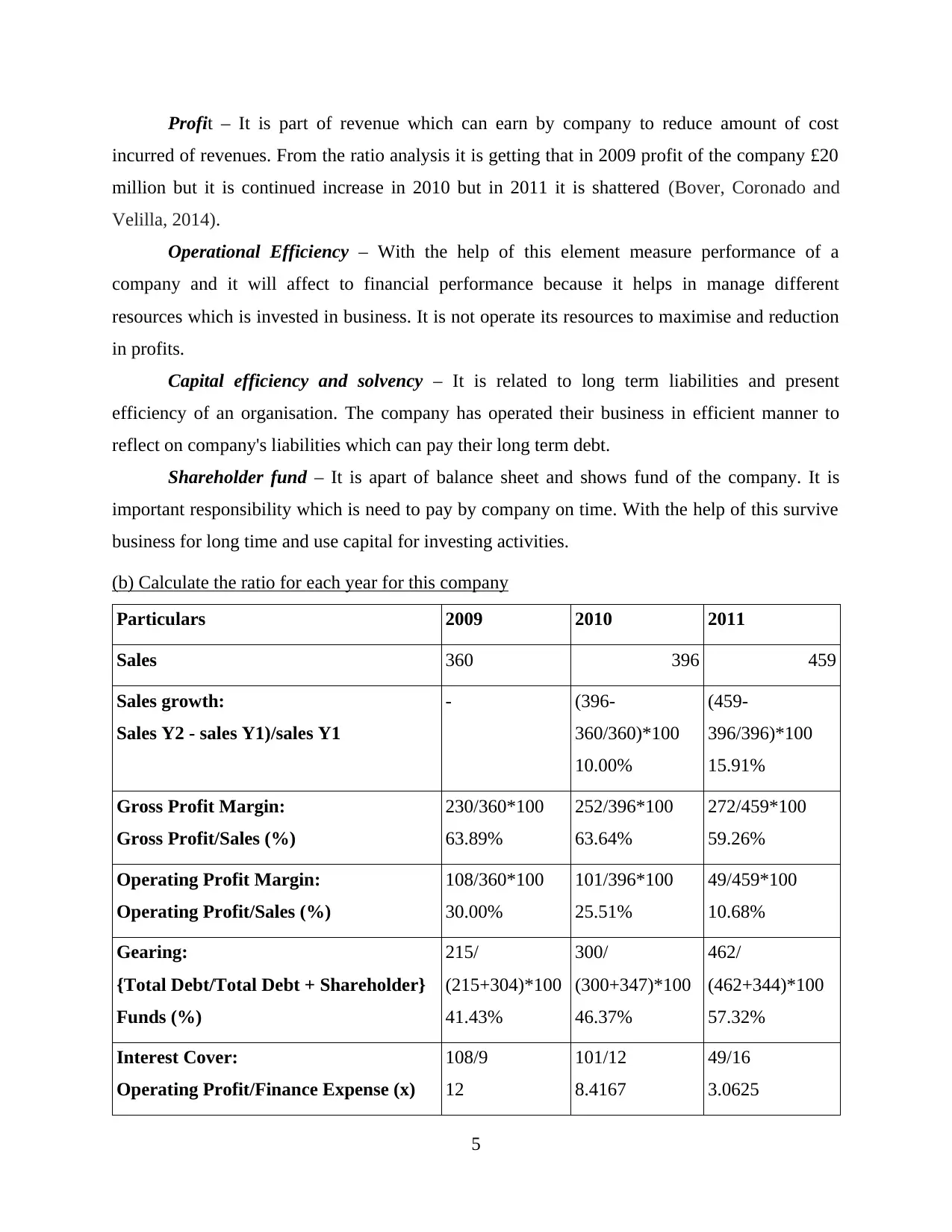
Profit – It is part of revenue which can earn by company to reduce amount of cost
incurred of revenues. From the ratio analysis it is getting that in 2009 profit of the company £20
million but it is continued increase in 2010 but in 2011 it is shattered (Bover, Coronado and
Velilla, 2014).
Operational Efficiency – With the help of this element measure performance of a
company and it will affect to financial performance because it helps in manage different
resources which is invested in business. It is not operate its resources to maximise and reduction
in profits.
Capital efficiency and solvency – It is related to long term liabilities and present
efficiency of an organisation. The company has operated their business in efficient manner to
reflect on company's liabilities which can pay their long term debt.
Shareholder fund – It is apart of balance sheet and shows fund of the company. It is
important responsibility which is need to pay by company on time. With the help of this survive
business for long time and use capital for investing activities.
(b) Calculate the ratio for each year for this company
Particulars 2009 2010 2011
Sales 360 396 459
Sales growth:
Sales Y2 - sales Y1)/sales Y1
- (396-
360/360)*100
10.00%
(459-
396/396)*100
15.91%
Gross Profit Margin:
Gross Profit/Sales (%)
230/360*100
63.89%
252/396*100
63.64%
272/459*100
59.26%
Operating Profit Margin:
Operating Profit/Sales (%)
108/360*100
30.00%
101/396*100
25.51%
49/459*100
10.68%
Gearing:
{Total Debt/Total Debt + Shareholder}
Funds (%)
215/
(215+304)*100
41.43%
300/
(300+347)*100
46.37%
462/
(462+344)*100
57.32%
Interest Cover:
Operating Profit/Finance Expense (x)
108/9
12
101/12
8.4167
49/16
3.0625
5
incurred of revenues. From the ratio analysis it is getting that in 2009 profit of the company £20
million but it is continued increase in 2010 but in 2011 it is shattered (Bover, Coronado and
Velilla, 2014).
Operational Efficiency – With the help of this element measure performance of a
company and it will affect to financial performance because it helps in manage different
resources which is invested in business. It is not operate its resources to maximise and reduction
in profits.
Capital efficiency and solvency – It is related to long term liabilities and present
efficiency of an organisation. The company has operated their business in efficient manner to
reflect on company's liabilities which can pay their long term debt.
Shareholder fund – It is apart of balance sheet and shows fund of the company. It is
important responsibility which is need to pay by company on time. With the help of this survive
business for long time and use capital for investing activities.
(b) Calculate the ratio for each year for this company
Particulars 2009 2010 2011
Sales 360 396 459
Sales growth:
Sales Y2 - sales Y1)/sales Y1
- (396-
360/360)*100
10.00%
(459-
396/396)*100
15.91%
Gross Profit Margin:
Gross Profit/Sales (%)
230/360*100
63.89%
252/396*100
63.64%
272/459*100
59.26%
Operating Profit Margin:
Operating Profit/Sales (%)
108/360*100
30.00%
101/396*100
25.51%
49/459*100
10.68%
Gearing:
{Total Debt/Total Debt + Shareholder}
Funds (%)
215/
(215+304)*100
41.43%
300/
(300+347)*100
46.37%
462/
(462+344)*100
57.32%
Interest Cover:
Operating Profit/Finance Expense (x)
108/9
12
101/12
8.4167
49/16
3.0625
5
Paraphrase This Document
Need a fresh take? Get an instant paraphrase of this document with our AI Paraphraser
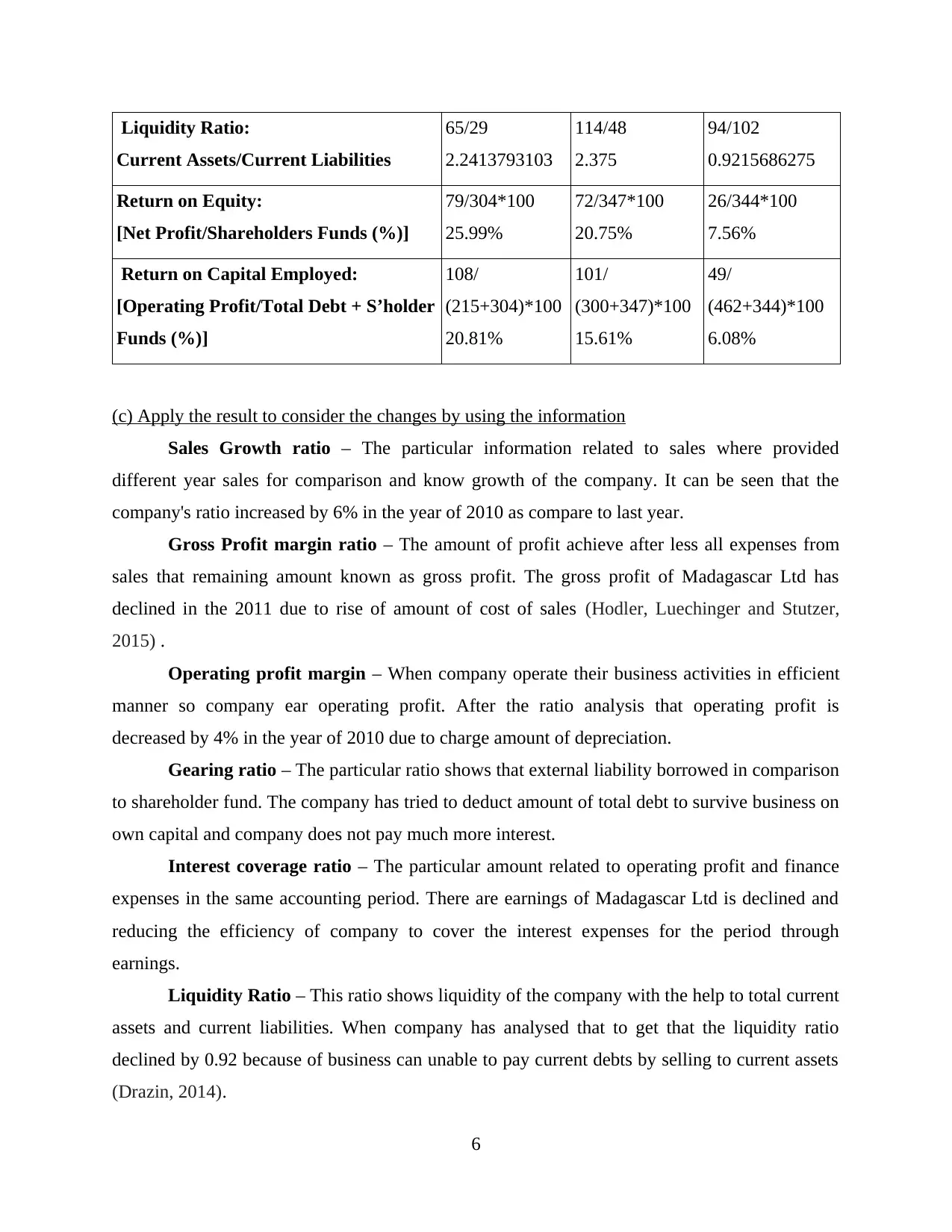
Liquidity Ratio:
Current Assets/Current Liabilities
65/29
2.2413793103
114/48
2.375
94/102
0.9215686275
Return on Equity:
[Net Profit/Shareholders Funds (%)]
79/304*100
25.99%
72/347*100
20.75%
26/344*100
7.56%
Return on Capital Employed:
[Operating Profit/Total Debt + S’holder
Funds (%)]
108/
(215+304)*100
20.81%
101/
(300+347)*100
15.61%
49/
(462+344)*100
6.08%
(c) Apply the result to consider the changes by using the information
Sales Growth ratio – The particular information related to sales where provided
different year sales for comparison and know growth of the company. It can be seen that the
company's ratio increased by 6% in the year of 2010 as compare to last year.
Gross Profit margin ratio – The amount of profit achieve after less all expenses from
sales that remaining amount known as gross profit. The gross profit of Madagascar Ltd has
declined in the 2011 due to rise of amount of cost of sales (Hodler, Luechinger and Stutzer,
2015) .
Operating profit margin – When company operate their business activities in efficient
manner so company ear operating profit. After the ratio analysis that operating profit is
decreased by 4% in the year of 2010 due to charge amount of depreciation.
Gearing ratio – The particular ratio shows that external liability borrowed in comparison
to shareholder fund. The company has tried to deduct amount of total debt to survive business on
own capital and company does not pay much more interest.
Interest coverage ratio – The particular amount related to operating profit and finance
expenses in the same accounting period. There are earnings of Madagascar Ltd is declined and
reducing the efficiency of company to cover the interest expenses for the period through
earnings.
Liquidity Ratio – This ratio shows liquidity of the company with the help to total current
assets and current liabilities. When company has analysed that to get that the liquidity ratio
declined by 0.92 because of business can unable to pay current debts by selling to current assets
(Drazin, 2014).
6
Current Assets/Current Liabilities
65/29
2.2413793103
114/48
2.375
94/102
0.9215686275
Return on Equity:
[Net Profit/Shareholders Funds (%)]
79/304*100
25.99%
72/347*100
20.75%
26/344*100
7.56%
Return on Capital Employed:
[Operating Profit/Total Debt + S’holder
Funds (%)]
108/
(215+304)*100
20.81%
101/
(300+347)*100
15.61%
49/
(462+344)*100
6.08%
(c) Apply the result to consider the changes by using the information
Sales Growth ratio – The particular information related to sales where provided
different year sales for comparison and know growth of the company. It can be seen that the
company's ratio increased by 6% in the year of 2010 as compare to last year.
Gross Profit margin ratio – The amount of profit achieve after less all expenses from
sales that remaining amount known as gross profit. The gross profit of Madagascar Ltd has
declined in the 2011 due to rise of amount of cost of sales (Hodler, Luechinger and Stutzer,
2015) .
Operating profit margin – When company operate their business activities in efficient
manner so company ear operating profit. After the ratio analysis that operating profit is
decreased by 4% in the year of 2010 due to charge amount of depreciation.
Gearing ratio – The particular ratio shows that external liability borrowed in comparison
to shareholder fund. The company has tried to deduct amount of total debt to survive business on
own capital and company does not pay much more interest.
Interest coverage ratio – The particular amount related to operating profit and finance
expenses in the same accounting period. There are earnings of Madagascar Ltd is declined and
reducing the efficiency of company to cover the interest expenses for the period through
earnings.
Liquidity Ratio – This ratio shows liquidity of the company with the help to total current
assets and current liabilities. When company has analysed that to get that the liquidity ratio
declined by 0.92 because of business can unable to pay current debts by selling to current assets
(Drazin, 2014).
6
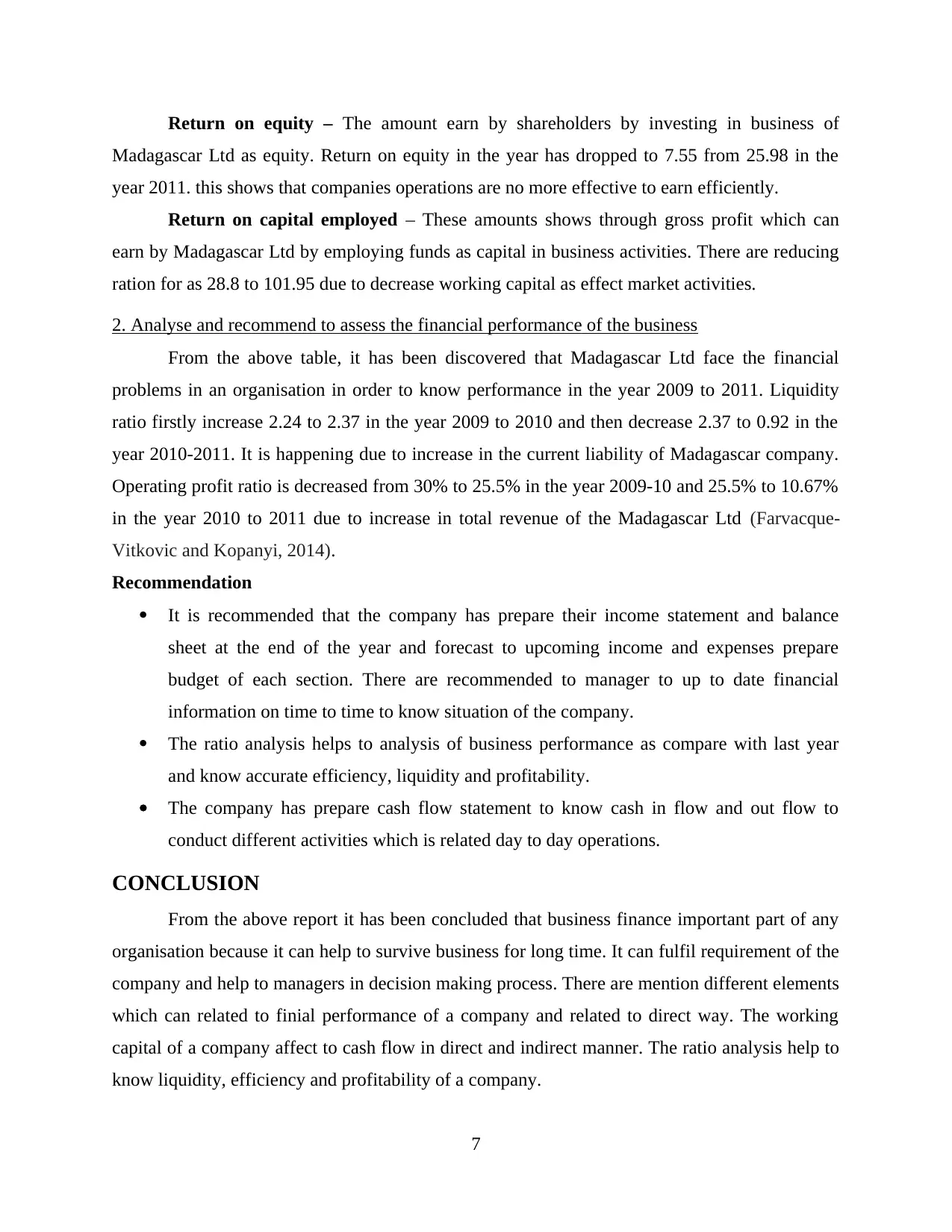
Return on equity – The amount earn by shareholders by investing in business of
Madagascar Ltd as equity. Return on equity in the year has dropped to 7.55 from 25.98 in the
year 2011. this shows that companies operations are no more effective to earn efficiently.
Return on capital employed – These amounts shows through gross profit which can
earn by Madagascar Ltd by employing funds as capital in business activities. There are reducing
ration for as 28.8 to 101.95 due to decrease working capital as effect market activities.
2. Analyse and recommend to assess the financial performance of the business
From the above table, it has been discovered that Madagascar Ltd face the financial
problems in an organisation in order to know performance in the year 2009 to 2011. Liquidity
ratio firstly increase 2.24 to 2.37 in the year 2009 to 2010 and then decrease 2.37 to 0.92 in the
year 2010-2011. It is happening due to increase in the current liability of Madagascar company.
Operating profit ratio is decreased from 30% to 25.5% in the year 2009-10 and 25.5% to 10.67%
in the year 2010 to 2011 due to increase in total revenue of the Madagascar Ltd (Farvacque-
Vitkovic and Kopanyi, 2014).
Recommendation
It is recommended that the company has prepare their income statement and balance
sheet at the end of the year and forecast to upcoming income and expenses prepare
budget of each section. There are recommended to manager to up to date financial
information on time to time to know situation of the company.
The ratio analysis helps to analysis of business performance as compare with last year
and know accurate efficiency, liquidity and profitability.
The company has prepare cash flow statement to know cash in flow and out flow to
conduct different activities which is related day to day operations.
CONCLUSION
From the above report it has been concluded that business finance important part of any
organisation because it can help to survive business for long time. It can fulfil requirement of the
company and help to managers in decision making process. There are mention different elements
which can related to finial performance of a company and related to direct way. The working
capital of a company affect to cash flow in direct and indirect manner. The ratio analysis help to
know liquidity, efficiency and profitability of a company.
7
Madagascar Ltd as equity. Return on equity in the year has dropped to 7.55 from 25.98 in the
year 2011. this shows that companies operations are no more effective to earn efficiently.
Return on capital employed – These amounts shows through gross profit which can
earn by Madagascar Ltd by employing funds as capital in business activities. There are reducing
ration for as 28.8 to 101.95 due to decrease working capital as effect market activities.
2. Analyse and recommend to assess the financial performance of the business
From the above table, it has been discovered that Madagascar Ltd face the financial
problems in an organisation in order to know performance in the year 2009 to 2011. Liquidity
ratio firstly increase 2.24 to 2.37 in the year 2009 to 2010 and then decrease 2.37 to 0.92 in the
year 2010-2011. It is happening due to increase in the current liability of Madagascar company.
Operating profit ratio is decreased from 30% to 25.5% in the year 2009-10 and 25.5% to 10.67%
in the year 2010 to 2011 due to increase in total revenue of the Madagascar Ltd (Farvacque-
Vitkovic and Kopanyi, 2014).
Recommendation
It is recommended that the company has prepare their income statement and balance
sheet at the end of the year and forecast to upcoming income and expenses prepare
budget of each section. There are recommended to manager to up to date financial
information on time to time to know situation of the company.
The ratio analysis helps to analysis of business performance as compare with last year
and know accurate efficiency, liquidity and profitability.
The company has prepare cash flow statement to know cash in flow and out flow to
conduct different activities which is related day to day operations.
CONCLUSION
From the above report it has been concluded that business finance important part of any
organisation because it can help to survive business for long time. It can fulfil requirement of the
company and help to managers in decision making process. There are mention different elements
which can related to finial performance of a company and related to direct way. The working
capital of a company affect to cash flow in direct and indirect manner. The ratio analysis help to
know liquidity, efficiency and profitability of a company.
7
⊘ This is a preview!⊘
Do you want full access?
Subscribe today to unlock all pages.

Trusted by 1+ million students worldwide
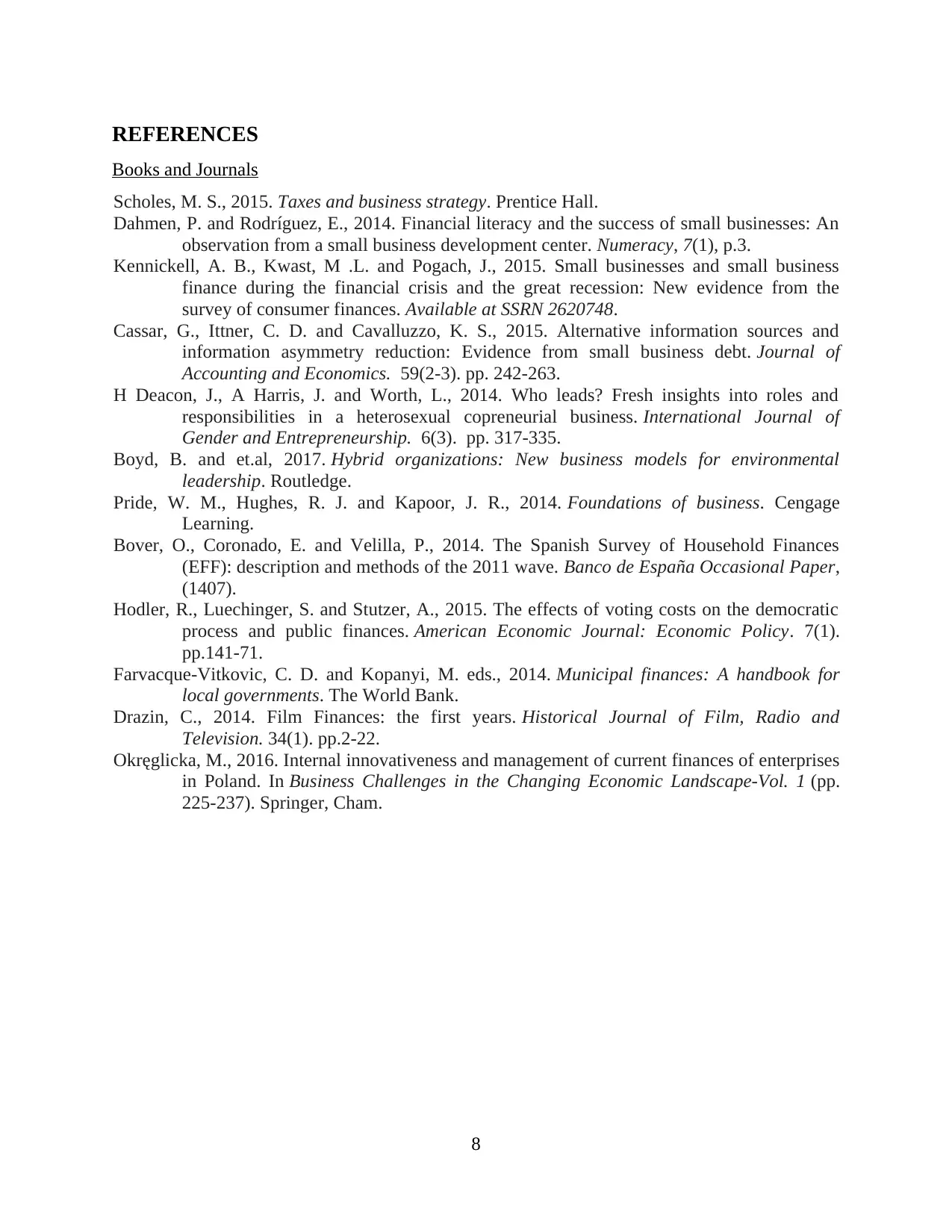
REFERENCES
Books and Journals
Scholes, M. S., 2015. Taxes and business strategy. Prentice Hall.
Dahmen, P. and Rodríguez, E., 2014. Financial literacy and the success of small businesses: An
observation from a small business development center. Numeracy, 7(1), p.3.
Kennickell, A. B., Kwast, M .L. and Pogach, J., 2015. Small businesses and small business
finance during the financial crisis and the great recession: New evidence from the
survey of consumer finances. Available at SSRN 2620748.
Cassar, G., Ittner, C. D. and Cavalluzzo, K. S., 2015. Alternative information sources and
information asymmetry reduction: Evidence from small business debt. Journal of
Accounting and Economics. 59(2-3). pp. 242-263.
H Deacon, J., A Harris, J. and Worth, L., 2014. Who leads? Fresh insights into roles and
responsibilities in a heterosexual copreneurial business. International Journal of
Gender and Entrepreneurship. 6(3). pp. 317-335.
Boyd, B. and et.al, 2017. Hybrid organizations: New business models for environmental
leadership. Routledge.
Pride, W. M., Hughes, R. J. and Kapoor, J. R., 2014. Foundations of business. Cengage
Learning.
Bover, O., Coronado, E. and Velilla, P., 2014. The Spanish Survey of Household Finances
(EFF): description and methods of the 2011 wave. Banco de España Occasional Paper,
(1407).
Hodler, R., Luechinger, S. and Stutzer, A., 2015. The effects of voting costs on the democratic
process and public finances. American Economic Journal: Economic Policy. 7(1).
pp.141-71.
Farvacque-Vitkovic, C. D. and Kopanyi, M. eds., 2014. Municipal finances: A handbook for
local governments. The World Bank.
Drazin, C., 2014. Film Finances: the first years. Historical Journal of Film, Radio and
Television. 34(1). pp.2-22.
Okręglicka, M., 2016. Internal innovativeness and management of current finances of enterprises
in Poland. In Business Challenges in the Changing Economic Landscape-Vol. 1 (pp.
225-237). Springer, Cham.
8
Books and Journals
Scholes, M. S., 2015. Taxes and business strategy. Prentice Hall.
Dahmen, P. and Rodríguez, E., 2014. Financial literacy and the success of small businesses: An
observation from a small business development center. Numeracy, 7(1), p.3.
Kennickell, A. B., Kwast, M .L. and Pogach, J., 2015. Small businesses and small business
finance during the financial crisis and the great recession: New evidence from the
survey of consumer finances. Available at SSRN 2620748.
Cassar, G., Ittner, C. D. and Cavalluzzo, K. S., 2015. Alternative information sources and
information asymmetry reduction: Evidence from small business debt. Journal of
Accounting and Economics. 59(2-3). pp. 242-263.
H Deacon, J., A Harris, J. and Worth, L., 2014. Who leads? Fresh insights into roles and
responsibilities in a heterosexual copreneurial business. International Journal of
Gender and Entrepreneurship. 6(3). pp. 317-335.
Boyd, B. and et.al, 2017. Hybrid organizations: New business models for environmental
leadership. Routledge.
Pride, W. M., Hughes, R. J. and Kapoor, J. R., 2014. Foundations of business. Cengage
Learning.
Bover, O., Coronado, E. and Velilla, P., 2014. The Spanish Survey of Household Finances
(EFF): description and methods of the 2011 wave. Banco de España Occasional Paper,
(1407).
Hodler, R., Luechinger, S. and Stutzer, A., 2015. The effects of voting costs on the democratic
process and public finances. American Economic Journal: Economic Policy. 7(1).
pp.141-71.
Farvacque-Vitkovic, C. D. and Kopanyi, M. eds., 2014. Municipal finances: A handbook for
local governments. The World Bank.
Drazin, C., 2014. Film Finances: the first years. Historical Journal of Film, Radio and
Television. 34(1). pp.2-22.
Okręglicka, M., 2016. Internal innovativeness and management of current finances of enterprises
in Poland. In Business Challenges in the Changing Economic Landscape-Vol. 1 (pp.
225-237). Springer, Cham.
8
1 out of 10
Related Documents
Your All-in-One AI-Powered Toolkit for Academic Success.
+13062052269
info@desklib.com
Available 24*7 on WhatsApp / Email
![[object Object]](/_next/static/media/star-bottom.7253800d.svg)
Unlock your academic potential
Copyright © 2020–2025 A2Z Services. All Rights Reserved. Developed and managed by ZUCOL.





